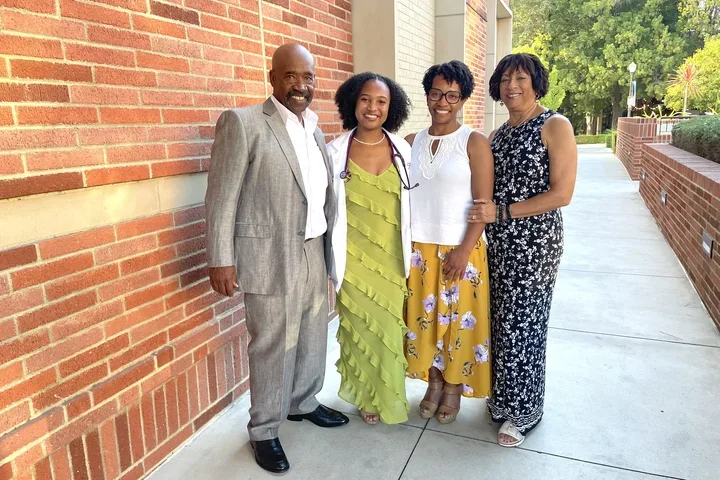Becoming a Doctor: Nichole Legaspi
Student Spotlight

How to Get Into UCLA Medical School
Nichole Legaspi’s aspirations to become a doctor started with a colon, or really, a colon sample.
Legaspi’s parents, immigrants from the Philippines, dreamed she would become a nurse. At sixteen, Legaspi interned at a hospital, intending to shadow a nurse but finding herself shadowing a pathologist instead.
She walked into the lab wondering what pathology was. She walked out in love with the field.
“The emergency room called, trying to figure out what was wrong with someone’s colon,” she recalls. “The pathologist flipped through a textbook and then cut into the colon sample. All these kidney bean things came out.”
He’d identified the issue; he’d treated a patient without even seeing the patient.
The pathologist’s distant but critical role in the care continuum appealed to Legaspi, who worried about possibly hurting patients while administering shots or performing procedures. She also felt enchanted by the equity implicit in working with samples.
“It didn't matter what gender you were. It didn't matter if you had cultural barriers. It didn't matter if you had language barriers. It didn't matter where you came from because every sample was treated the same and got the same care every time,” she says.
“I fell in love with that.”
Cultural Barriers Divert Med School Dreams
The equitable treatment Legaspi saw in the pathology lab contrasted with her personal healthcare experiences as a child of immigrants.
“I grew up with skepticism of the healthcare system because there were a lot of cultural barriers for people from the Philippines navigating care in the United States.”
In pathology, Legaspi saw an opportunity to transcend those obstacles, but her parents struggled to understand her dream.
“When I told my Mom I wanted to become a pathologist, she just said, ‘How long is that going to take?’”
In Filipino culture, parents expect their children to care for them, a responsibility that could be challenging for a busy medical trainee.
Legaspi pivoted her plans and decided to spend fewer years in school by becoming a Clinical Lab Scientist (CLS). Internships she completed at Stanford and also Johns Hopkins reignited her medical dreams.
“I met people from disadvantaged backgrounds like mine, who weren’t deterred by the disparities they’d experienced, but motivated to pursue careers in medicine because of them.”
The internships left Legaspi believing, despite her family’s misgivings, that she could actually become a doctor. She began studying for the Medical College Admission Test (MCAT), but soon found herself dealing with a devastating family tragedy.
“I had to work on my mental health and also try to piece my family together,” she says, explaining how she went to Hawaii, trying to reclaim some peace. “I learned you can move yourself physically, but if you don’t do the internal work, it doesn’t matter where you are.”
Knowing she wasn’t completely okay or completely prepared, Legaspi pressed forward with her medical-school applications as though on autopilot.
When she learned she didn’t get into the David Geffen School of Medicine at UCLA (DGSOM), her top choice, she felt crushed.
“But because I had survived everything with my family, I knew I could get through this too, and I couldn’t see myself doing anything else but going to medical school,” Legaspi says.
“I just knew I had to figure out how to get there.”

Refocusing and Applying to Medical School
Legaspi reflected on her strengths, weaknesses, and circumstances, determining what she had the power to change. She isolated the MCAT as her Achilles heel and enlisted two friends who’d been through it to help her study.
“I gave it everything I had,” she says. “I adjusted my work schedules. I was very transparent that I was applying to medical school and set boundaries with everyone in my life.”
She celebrated milestones on the way to completing her application.
“You shouldn’t wait until you get into medical school or get a perfect MCAT score to celebrate. You should celebrate your success on the way because you’re a whole person and life happens. I think I would have burnt out if I didn’t do that.”
Just a few months after she finished her second round of applications, DGSOM invited her to do an interview. She hadn’t felt optimistic about her odds as someone applying through the UCLA Re-Application Program, and getting a second chance made her rethink her entire approach.
“I took a very cookie-cutter approach to my first interview. I thought if I played by the rules, I would get in, but I didn’t. So this time, I went in with the intention of showing them who I am. I told myself, ‘If they take me, they do. If they don't, they don't.’”
Legaspi had thought her first interview went well; she knew her second interview went well—very well.
“They asked me about things I didn’t think they would,” she explains. “We talked about how I foster kittens and how I felt that made me more attentive to non-verbal cues I might observe in patients experiencing language barriers.”
A few months after the interview, she received a congratulations voicemail from the DGSOM admissions office. She didn’t believe it could be real. She thought she’d misheard the message or that the admissions office had made a mistake. However, when she received the offer letter via email, complete with an official letterhead and a dean’s signature, she knew it was time to celebrate.

Supporting Disadvantaged Students
Legaspi spent the next few months in a state of cautious bliss.
“I was waiting to wake up from this dream because I knew what it feels like to have things go wrong.”
This time around, things got better. She’ll never forget being at the back of a noisy bus and seeing an incoming call from an unknown number. Expecting spam, she answered gruffly. Then the voice she could barely hear over the bus’s commotion identified itself as Jennifer Lucero, Associate Dean for Admissions at the DGSOM.
“She said, ‘I just wanted to let you know that you were picked to get one of the David Geffen Medical Scholarships.’”
Stunned, Legaspi asked Dean Lucero to repeat herself. She felt almost too thankful to speak. Paying for her education by taking out loans and possibly finding work made her anxious, but she’d been ready and willing to do so. Getting the support she needed to fully focus on her education felt like yet another dream come true.

A Vision for Positive Change in the Healthcare System
DGSOM had always been Legaspi’s top-choice medical school. She got a sense it aligned perfectly with her values and also her future career goals. Her intuition proved correct. Within a few weeks of starting med school, she felt a sense of belonging she’d always longed for.
“I felt so thankful to be here and meet so many people who care about all the things I do.”
Now president of the DGSOM/Charles Drew University (CDU) Pride Alliance and a coordinator of the Pathology Interest Group, she loves being surrounded by people who want to create positive change in the healthcare system.
“In my other clinical experiences, I encountered a lot of good people but also people who were beat down by the system. It feels so good to be around people who want to, and believe they can, make things better.”
Family also inspires Legaspi to keep working toward positive change.
“I wouldn't be here without them. I wouldn't be the person I am without them. They are the foundation of my being, and I love them so much.”
She believes all the negative encounters that led them to be suspicious of the healthcare system and less than supportive of her career path can be corrected by the next generation of physicians.
“More people like me are getting into medicine. If we hold true to our values and our lived experiences, we can add that missing piece of understanding textbooks can’t teach.”
Legaspi empathizes with anyone who’s treated differently because they look different. Her personal history deeply informs how she intends to treat her future patients.
“I can't tell you how many times I’ve walked into a room and experienced people making assumptions about me out of nowhere,” she says. “I plan to listen without making assumptions and to work with patients to figure out what really works best for them instead of making dismissive mandates.”
Med School Advice - Quick Tips
- When approaching medical school applications and interviews, be yourself. If you try too hard to fit a mold, you might end up diminishing what makes you a unique person and a stand-out applicant.
- If you know deep down that medicine is the path for you, then don’t give up. If you stay persistent and open-minded about changes you can make, then no rejection or setback needs to be the end of the road.
- Prioritize your mental health and be honest about what you need. Goals will be harder to reach if you don’t first care for yourself.
Med School Advice - FAQ
What Is a First Generation College Student?
A first-generation college student is the first in their family to attend college. Read more about first-generation medical students at the DGSOM.
According to the most recent report available from the Association of American Medical Colleges (AAMC):
- The average cost of attending one year of private medical school in the United States is $39,905.
- The average cost of attending one year of public medical school in the United States is $62,570.
See the costs associated with attending medical school at the DGSOM.
How Long Is Medical School?
Many medical schools offer a four-year medical education curriculum. After students complete this core curriculum, they spend several (3-7) more years in residency training for their chosen specialty.
How Hard Is Medical School?
Medical school is hard because being an outstanding physician or physician scientist is hard. Most medical schools design rigorous curriculums that prepare medical students for the range of challenges they’ll encounter every day as practicing physicians.



